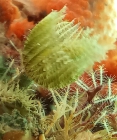| Introduction | | Species lists | | Search taxa | | Taxon tree | | Literature | | Distributions | | Statistics | | Editors | | Match taxa | | Webservice | | Log in |
WoRMS taxon detailsBranchiomma Kölliker, 1858
129524 (urn:lsid:marinespecies.org:taxname:129524)
accepted
Genus
Dasychone Sars, 1862 · unaccepted (subjective synonym)
Dasychonopsis Bush, 1905 · unaccepted (subjective synonymy (type species))
Sabella (Dasychone) Sars, 1862 · unaccepted (superseded subgenus rank for...)
superseded subgenus rank for subjective synonym
marine,
recent only
Kölliker, A. (1858). Ueber Kopfkiemer mit Augen an den Kiemen. <em>Zeitschrift für wissenschaftliche Zoologie.</em> 9: 536-541., available online at http://biodiversitylibrary.org/page/13863875 [details]
Taxonomy Kölliker introduces his new genus Branchiomma briefly in passing, while making extensive comments on Dalyell's species...
Taxonomy Kölliker introduces his new genus Branchiomma briefly in passing, while making extensive comments on Dalyell's species Amphitrite bombyx, thus ("Was das Aeussere der fraglichen Annelide betrifft, die ich mit dem Namen Branchiomma Dalyellii bezeichnen will, da dieselbe auf jeden Fall eine neue Gattung darstellt ..."). The name Branchiomma dalyellii is a superfluous species name as the new combination should have been Branchiomma bombyx [details]
Read, G.; Fauchald, K. (Ed.) (2024). World Polychaeta Database. Branchiomma Kölliker, 1858. Accessed through: World Register of Marine Species at: https://www.marinespecies.org/aphia.php?p=taxdetails&id=129524 on 2024-11-15
Date action by
original description
Kölliker, A. (1858). Ueber Kopfkiemer mit Augen an den Kiemen. <em>Zeitschrift für wissenschaftliche Zoologie.</em> 9: 536-541., available online at http://biodiversitylibrary.org/page/13863875 [details]
original description (of Dasychone Sars, 1862) Sars, M. (1862). Foredrag om de ved Norges Kyster forekommende Arter af den Linnéiske Annelideslægt Sabella. <em>Forhandliger I Videnskabs Selskabet i Christiania.</em> 1861: 116-133. page(s): 118 [details] original description (of Dasychonopsis Bush, 1905) Bush, K.J. (1904 (1905)). Tubicolous annelids of the tribes Sabellides and Serpulides from the Pacific Ocean. <em>Harriman Alaska Expedition.</em> 12: 169-346, plates XXI-XLIV., available online at https://www.biodiversitylibrary.org/page/22063650 page(s): 198 [details] additional source Keppel, Erica; Tovar-Hernández, Maria Ana; Ruiz, Gregory. (2015). First record and establishment of <em>Branchiomma </em><em>coheni </em>(Polychaeta: Sabellidae) in the Atlantic Ocean and review of non–indigenous species of the genus. <em>Zootaxa.</em> 4058(4): 499-518., available online at https://doi.org/10.11646/zootaxa.4058.4.3 note: checklist of species, noting which are recorded as introduced [details] additional source Bellan, G. (2001). Polychaeta, <i>in</i>: Costello, M.J. <i>et al.</i> (Ed.) (2001). European register of marine species: a check-list of the marine species in Europe and a bibliography of guides to their identification. <em>Collection Patrimoines Naturels.</em> 50: 214-231. (look up in IMIS) [details] additional source Day, J. H. (1967). [Sedentaria] A monograph on the Polychaeta of Southern Africa. Part 2. Sedentaria. British Museum (Natural History), London. pp. 459–842., available online at http://www.biodiversitylibrary.org/bibliography/8596 [details] additional source Claparède, Édouard. (1869). Les Annélides Chétopodes du Golfe de Naples. Seconde partie. Ordre II<sup>me</sup>. Annélides Sédentaires (Aud. et Edw.). <em>Mémoires de la Société de Physique et d'Histoire Naturelle de Genève.</em> 20(1): 1-225, plates XVII-XXXI., available online at https://biodiversitylibrary.org/page/14264110 note: Claparède reinterpreted Branchiomma of Kölliker for another species he named, but this was not possible [details]  Present Present  Inaccurate Inaccurate  Introduced: alien Introduced: alien  Containing type locality Containing type locality
From editor or global species database
Editor's comment Some authors, notably Johansson (1926, 1927), and the Hartman catalogue, and even recent authors, mistakenly treated Claparède's later use of Branchiomma as if it was a homonym accidentally introduced. This is incorrect as it is very clear he was using the genus name of Kölliker (he attributes the genus to Kölliker), although attempting to redefine it for his own species. [details]Grammatical gender Genus Branchiomma is neuter, as deriving from the neuter Greek word for eye, omma, ommatos. Some authors from at least the 1880s recognized this, but others treated it as feminine. Of significant modern authors Knight-Jones (eg 1994) was probably first consistently to make gender corrections of existing epithets [details] Taxonomy Kölliker introduces his new genus Branchiomma briefly in passing, while making extensive comments on Dalyell's species Amphitrite bombyx, thus ("Was das Aeussere der fraglichen Annelide betrifft, die ich mit dem Namen Branchiomma Dalyellii bezeichnen will, da dieselbe auf jeden Fall eine neue Gattung darstellt ..."). The name Branchiomma dalyellii is a superfluous species name as the new combination should have been Branchiomma bombyx [details] From regional or thematic species database
Introduced species vector dispersal Galapagos part of the South Pacific Ocean (Marine Region) Ships: accidental as attached or free-living fouling organisms[details] Introduced species vector dispersal Galapagos part of the South Pacific Ocean (Marine Region) Ships: accidental with ballast water, sea water systems, live wells or other deck basins [details] Unreviewed
Habitat Known from seamounts and knolls [details]
|

